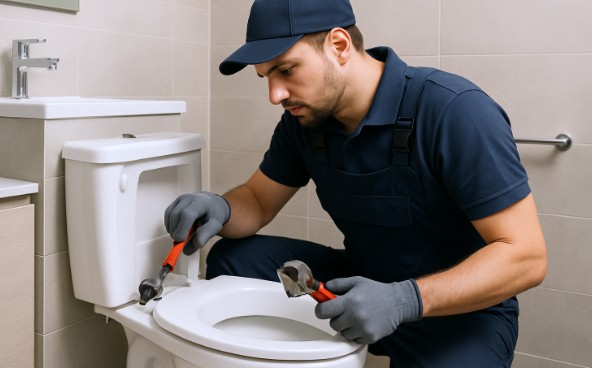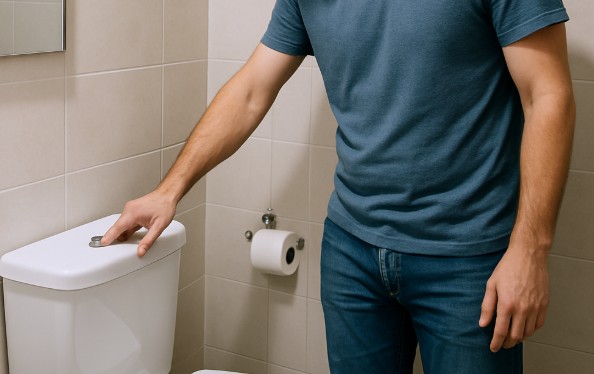So, picture this: You flush the toilet and just as you’re about to walk away, your bathroom starts sounding like it’s trying to join a symphony. A sharp, high-pitched whistle rings out. It’s loud. It’s weird. And frankly, it’s kind of embarrassing if guests are over.
If your toilet’s making noise like a tea kettle after every flush, you’re not alone. This is one of those oddly common plumbing quirks that people know is a little off—but they’re not quite sure what it means or whether they should be worried.
Spoiler: your toilet isn’t haunted, but it is trying to tell you something. Let’s break it all down—what causes that strange whistling sound, whether it’s serious, and what you can do about it.
So… Why Is My Toilet Whistling?
That eerie whistling noise usually happens after the flush, when the tank is refilling. That gives us a big clue: the sound is related to water flow, specifically inside the toilet’s tank.
Here’s the simple breakdown:
The usual culprit is your toilet’s fill valve. This is the mechanism responsible for refilling the tank with water after each flush. As it ages or wears out, it doesn’t open and close as smoothly as it should, and that restriction in water flow creates vibration—which becomes a whistle.
In most cases, the fill valve is:
- Old
- Worn out
- Has buildup from hard water
- Or was just cheaply made to begin with
Why Does It Whistle Instead of Gurgle or Hum?
The whistle comes from water forcing its way through a narrow or partially blocked space—kind of like blowing air through pursed lips. It creates a high-frequency sound as water vibrates internal parts of the valve.
If the sound is more of a hum or groan, that might be something else (like a different plumbing issue). But a whistle? That’s a classic fill valve drama.
Age Is a Factor (Like Most Things in Plumbing)

If your toilet is older (say, over 8–10 years) and you’ve never replaced any of the inner components, odds are that your fill valve is wearing out. Mineral buildup from hard water or corrosion inside the valve can mess with its ability to regulate water pressure.
The result? You get that shrieking little whistle every time your toilet does its job.
What Kind of Fill Valve Do I Have?
There are a few different types of fill valves:
- Ballcock valves (older style): These often whistle when the float arm or washer wears out.
- Float cup valves (modern style): More efficient and quieter, but not immune to wear and tear.
- Diaphragm-type fill valves: These rely on rubber seals that degrade over time and can absolutely whistle when things get funky.
Whichever kind you have, the solution is usually the same: clean it or replace it.
How to Fix a Whistling Toilet (Step-by-Step)
Ready to get your toilet to chill out? Here’s what you can do.
Option 1: Try Cleaning the Fill Valve
If you’re handy and feeling adventurous, turn off the water supply and:
- Flush the toilet to empty the tank.
- Remove the top of the fill valve (check your brand’s instructions—you might need to twist or unclip it).
- Rinse out any debris or mineral buildup.
- Reassemble and turn the water back on.
Sometimes, a little gunk is all that’s causing the squealing.
Option 2: Just Replace the Fill Valve
Let’s be real—fill valves are cheap. A brand-new, quiet-fill valve costs $10–20 and can save you a lot of noise and hassle.
Steps to replace:
- Shut off the water supply (there’s a shutoff valve under the toilet).
- Flush and hold the lever to empty the tank.
- Sponge or towel out any remaining water (yes, it’s boring—but worth it).
- Unscrew the old fill valve from underneath the tank.
- Install the new one according to the instructions (it’s easier than it sounds).
- Turn the water back on and test it.
Most new fill valves are designed to be whisper-quiet and efficient. Problem solved.
Other Possible (But Less Common) Causes
Okay, let’s say you already replaced the fill valve and it still sounds like your toilet is practicing for band camp. Here are a few other things to check:
1. Water Pressure Too High
Excessive water pressure can cause all kinds of strange noises in your plumbing. If your whole house sounds like a wind tunnel when water is running, it might be worth having a plumber check your pressure regulator.
2. Mineral Buildup in Pipes
If you live in an area with hard water, mineral deposits can form inside your plumbing over time, leading to whistling or hissing noises. A whole-house water softener might help long-term.
3. Loose Pipes
If the whistle is accompanied by vibration or rattling, it could be loose pipes reverberating behind the wall. That’s a bigger job and may require a plumber to secure things.
Why Fixing It Matters (Besides Your Sanity)

Besides being incredibly annoying, a whistling toilet is telling you that a part inside it isn’t working properly. That can lead to:
- Leaks (hello, water damage)
- Inefficient flushing
- Increased water bills
- Or worse, a toilet that won’t stop running
You don’t want your toilet to turn passive-aggressive. Fixing the noise now avoids a bigger headache later.
Silence Is Golden (Especially in the Bathroom)
A whistling toilet might seem like a harmless little quirk—but it’s also your toilet’s way of saying, “Hey, something’s not right in here.”
The good news? You don’t need a full plumbing degree to fix it. With a bit of time (and maybe a trip to the hardware store), you can replace that tired old fill valve, say goodbye to the bathroom whistle, and enjoy the sweet, sweet sound of silence.
So go ahead—flush in peace. You’ve earned it.



